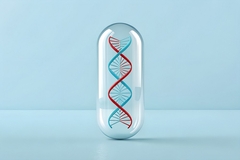Keep a Watchful Eye on Sugary Beverage Consumption

Choose beverages that hydrate and contribute to good nutrition and oral health. Drinking eight to 12 cups of water daily is important, and consuming optimally fluoridated water helps to prevent tooth decay.
11/01/08 Consumption of sugary beverages can do quite a number on your teeth. Did you know that some soft drinks contain as much as 11 teaspoons of sugar per serving and that most soft drinks also contain phosphoric and citric acids? Prolonged exposure to these acids can cause erosion, the loss of hard tissue from the tooth surface.
According to Dr. Bruce Terry, a Pennsylvania Dental Association (PDA) member and endodontist from Wayne, a recent study conducted by the American Society for Biochemistry and Molecular Biology suggests that excess drinking of sugary beverages may increase the risk of Alzheimer's disease.
In 2000, Americans drank more than 53 gallons of soft drinks per person. This amount surpassed all other beverages, including milk and water. One out of every four beverages consumed in the United States today is a soft drink.
With the high amount of sugary beverages being consumed daily, PDA stresses the importance of watching the amount of sugary beverages that you or your children drink, including soda, juice drinks, sports (electrolyte replacement) drinks with added sugars and other beverages that contain added sugars.
Every time you or your child eat or drink sugary substances, bacteria combine with the sugar to produce harmful acids, which attack the teeth for at least 20 minutes. After multiple attacks, teeth are susceptible to decay. If a dentist does not remove the decay and place a filling, decay can spread to the rest of the tooth.
There are steps being taken to try to reduce consumption of sugary beverages. On May 3, 2006, the Alliance for a Healthier Generation, the American Beverage Association (ABA) and three beverage producers, Cadbury Schweppes Americas Beverages, The Coca-Cola Company and PepsiCo, Inc., launched an initiative to phase out the sale of all full-calorie carbonated soft drinks (CSD) in schools across the United States and shift towards more lower-calorie and nutritious options.
In September 2007, the first School Beverage Guidelines Progress Report (2006-2007) was released by Dr. Robert Wescott, an independent economist. The report found that after one year of implementation, the new initiative cut calories significantly in schools. Shipments of full-calorie CSDs to schools were 45 percent lower during the 2006-07 school year than they were in 2004, with the average student purchasing only 5.9 ounces, less than a half a can, of such drinks per week, as compared to 12.5 ounces per week in 2004.
While these are significant strides in the battle against sugary beverages in schools, there is still a long way to go. PDA recommends cutting down on sugary snacks and beverages, while eating a variety of nutritious foods from the five major food groups. Choose beverages that hydrate and contribute to good nutrition and oral health. Drinking eight to 12 cups of water daily is important, and consuming optimally fluoridated water helps to prevent tooth decay.












